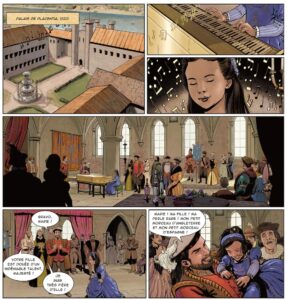Delcourt editions offer, in the historical series Queens of Blood, portraits of women who marked their time but then disappeared in the dust of time. However, Mary Tudor is an exception and this first volume proves why this woman has become a figure still relevant.
A king's daughter who emancipates herself

From the beginning, the screenwriter Corbeyran was interested in the daily life of the great figure of history. On February 18, 1516, the King of England, Henry VIII, waited in his palace for the birth of his first child. He is very worried because his four children died in infancy. This will not be the case with Mary. The young woman grew up pampered by her royal father. He is proud of his daughter for her talent as a musician. Through the example of Mary Tudor, the reader follows the education of a princess. She has tutors but her mother keeps a big role. She gave him models of life, also taught him Latin, French and Spanish. Indeed, Mary Tudor, is a child of two cultures. She is above all English by her father and her place of life, but her mother wants to pass on to her the heritage of the family of Aragon. These facts seem to come from many researches of the screenwriter Corbeyran from letters of Mary. However, some elements seem anachronistic: her mother wants the princess to choose her husband.
Marie Tudor is also the story of a complicated relationship between a father and his daughter, where love and reason of state mingle. Her life is hectic, but at first she can't do anything about it. The eldest, Mary is the heir to the throne of England. Yet no woman has actually exercised power. In order to ensure her future as wife of the King of England, a ceremony simulates her marriage with the heir to the throne of France, the son of Francis Iwhile she is still a baby. As an adult, she is exiled to a castle on the edge of Wales, but this situation may be a promise of rich opportunities…
The intimate joins the great story

Through the tumultuous biography of Mary Tudor, the screenwriter details the birth of Anglicanism, a religion created for a woman. It takes up the black legend making Anne Boleyn a harmful force compared to a manipulated and deceived Henry VII. Focusing on couple affairs, he set aside other causes such as a desire for national independence. This first volume gives a feminism vision of this period. The intimate medicine of women is poorly known because all doctors are men. Certain school subjects were forbidden to Mary Tudor. The queen was not supposed to reign but everything changes because her mother can not have other children. Henry VIII finds a radical solution…
This first volume is therefore a dense historical narrative. The characters and events are numerous. The cartoonist Claudio Montalbano manages very well to convey this complexity. His realistic style is classic in historical comics. The multiple landscapes and the very varied architectures are very beautiful. The faces seem inspired by period portraits but they struggle to move in a box. The integration of the text with large bubbles and a rather banal font can be surprising. Conversely, colorist Jean-Paul Fernandez remains very classic with realistic colors in a dark tone.
The first volume of the new series of Blood Queens is a succession of dramas. Yet Mary Tudor proved to be a faithful and pious princess who refused to yield to her father's powerful wrath. Like Game of Thrones, the book ends with a very successful dynastic cliffhanger.
Find other stories from this collection with Cleopatra and The Three Julias.






































